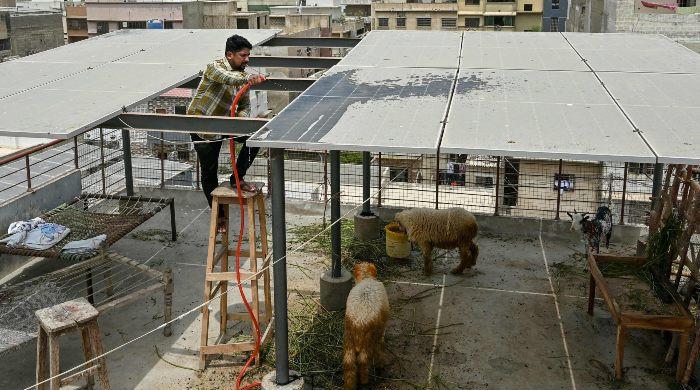Pakistan’s Solar Power Surge: Households Ditch National Grid
Across Pakistan, an increasing number of citizens are opting for solar energy solutions, resulting in a surge in rooftop solar panel installations. This shift is posing challenges for the government, which is already struggling with substantial debts in the power sector.
This energy transition is gaining traction from affluent areas to both middle and lower-income households. Consumers are seeking alternatives to combat rising electricity costs and frequent power outages.
In a densely populated area of Karachi, residents are gathering at Fareeda Saleem’s home to benefit from a consistent power supply, a novel experience for them.
“Solar power improves our lives, but it requires a significant initial investment for many,” Saleem commented, highlighting the financial strain.
Saleem disconnected from the national grid the previous year in protest of the persistent 18-hour power cuts. As a widow and mother of two children with disabilities, she made the difficult decision to sell her jewelry and borrow funds from relatives to purchase two solar panels, an inverter, and a battery for energy storage, totaling Rs180,000.
With temperatures exceeding 40 degrees Celsius, children seek refuge in Saleem’s home, enjoying the cool breeze from her fan.
Rapid Solar Adoption
Solar panels are now a prevalent sight on rooftops throughout the nation. The initial investment is typically recouped within two to five years.
In 2020, solar power constituted less than 2% of Pakistan’s energy sources. However, by 2024, this figure rose to 10.3%, according to Ember, a global energy think tank.
Notably, in the first five months of 2025, solar power more than doubled to 24%, establishing itself as the primary energy production method.
Solar has now outpaced gas, coal, nuclear energy, and hydropower, despite substantial investments in the latter over the decades.
Renewable Energy Target
Consequently, Pakistan is progressing towards its goal of sourcing 60% of its energy from renewable sources by 2030.
Dave Jones, the chief analyst at Ember, recognized Pakistan as “a leader in rooftop solar”.
Factors Driving the Transition
Mounting global fuel expenses, coupled with demands from the International Monetary Fund to reduce government subsidies, have compelled successive administrations to repeatedly increase electricity costs.
Since 2022, electricity prices have seen fluctuations, peaking at a 155% surge, leading to power bills sometimes exceeding rental costs.
Muhammad Basit Ghauri, an energy transition expert at Renewables First, explained that “the rapid adoption of solar energy is driven by widespread dissatisfaction with the existing power system, which is plagued by inefficiencies.”
Most solar equipment comes from China, where overproduction and technological advancements have substantially reduced prices.
Government Challenges
The decline in national grid consumers has caught the government off guard, which is already burdened with $8 billion in power sector debt, analysts report.
Pakistan relies heavily on importing expensive gas, which is then sold to national energy providers at a loss.
The government is also bound by long-term agreements with independent power producers, including Chinese-owned entities, requiring fixed payments regardless of actual demand.
A government report from March indicated that the increased use of solar power has placed a “disproportionate financial burden on grid consumers, contributing to elevated electricity tariffs and jeopardizing the energy sector’s stability.”
Electricity sales experienced a 2.8% year-on-year drop in June, marking the second consecutive year of decline.
Government Measures
Recently, the government introduced a 10% tax on all imported solar equipment, and the energy ministry has proposed reducing the rate at which excess solar energy is purchased from consumers.
Analyst Jones cautioned that “the household solar surge was a reaction to a crisis, not the cause,” also pointing out potential grid challenges, such as surges in the evening when solar users revert to traditional power sources.
Individual Benefits
The national grid is losing paying customers like Arsalan Arif. He was spending a significant portion of his earnings on electricity until he invested approximately Rs1.4 million in a 10-kilowatt solar panel system for his Karachi residence.
Now, he has “freedom and certainty” to continue his catering business without the disruption of power outages.
In Sialkot, Hammad Noor, a safety wear manufacturer, transitioned to solar power in 2023, calling it his “best business decision”. He recouped his investment within 18 months and now saves Rs1 million each month.
However, due to the new government tax, the cost of converting Noor’s second factory has increased by nearly Rs1.5 million.
He argued that “the imposed tax is unfair, benefiting larger businesses at the expense of smaller ones” and added that “policymakers appear detached from the public and business community.”



Comments (0)
No comments yet. Be the first to comment!
Leave a Comment